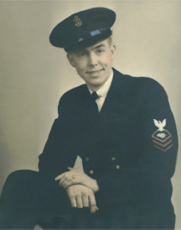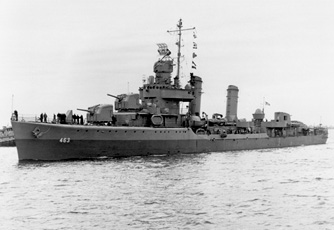|
On St. Patrick’s Day, (March
17) 1944, off the northwest coast of Africa near the Cape Verde islands, a
German submarine was trying to elude us. We’d been constantly pursuing it,
zigzagging in a game of cat and mouse for some 16 hours. Sometimes we
thought we’d lost it; then we would pick it up on sonar again. Each time
we’d make sound contact, we would drop depth charges, but the explosions
brought nothing to the surface. We were about to head back to the aircraft
carrier USS Block Island (CVE-21) to get a full load of depth charges
and let the USS Bronstein (DE-189) continue the hunt, but then an oil
slick was noticed in the water, so we stayed in the area.
The Corry’s crew had been in what is called pursuit mode—not yet at
full battle stations but ready to move when the alarm sounded. Around
mid-day, after we regained sound contact and dropped more depth charges,
finally, our lookouts spotted a U-boat surfacing less than a mile away from
us. Over the bullhorn, loud and clear came the alert, “Submarine on the
surface! Submarine on the surface! All hands! Man your battle stations! All
hands! Man your battle stations!” It was the U-801. Our depth charges
had caused enough damage that the sub had begun to take on water. The only
two choices it had were to surface quickly or to stay down and continue to
sink.
In addition to the Corry’s mounted guns, practically every available
man on the ship was equipped with small arms out on deck. We weren’t going
to take any chances if that sub might have a mounted 6-inch gun, which
would be even more deadly than our 5-inchers. Just one well-placed shot from it could do
considerable, even lethal, damage to a tin can like ours. The first place
they’d probably try to aim for would be our torpedoes amidships. U-boats
also were equipped with several mounted heavy-caliber automatic weapons that could
cut things up quite a bit. Even though I was chief radio technician, I was
at the bow of the Corry, ready with a .30-06 rifle in my hands and a
Thompson submachine gun at my side. My six years of infantry marksmanship
before the war would be valuable experience now. [Mac served six years as an
infantry radioman in the Pennsylvania National Guard from 1934-1940.]
As the U-boat surfaced, from a distance we opened fire on it with our main
5-inch guns and all other guns that could bear. Some of the shots hit the
conning tower of the sub. As soon as the sub’s crew felt the hits and saw
big splashes going up all around them, they immediately abandoned the
vessel, pouring out of several hatches and jumping over the side, getting as
far away from it as they could. They would put up no fight today.
With the U-boat crew abandoning, a cease-fire was ordered. We all watched as
the sub began to slowly take on more water. However, it wasn’t sinking fast
enough for our captain. To speed the process, as we moved in a little closer
he ordered our 5-inchers, as well as our 40-millimeter and 20-millimeter
guns, to fire on it some more. Then everyone with small arms also got into the
act and started shooting at the sub. Extra small arms were passed out on
deck for even more crewmembers to fire with.
Yet, despite everything we were firing into it, the U-801 still wasn’t
sinking fast enough, so our captain decided that he was going to ram it with
the Corry to ensure that it would sink. Hearing this, we thought, Ram
it? Won’t that hurt the Corry more than the U-boat? We don’t have a
ramming bow. The captain was resolute, however. He exclaimed, “It’s not
sinking fast enough! Full speed ahead! Ram it!” I ran away from that bow
faster than I’d moved in quite some time. We all braced ourselves for
collision as the Corry steamed through the water and closed in on the
dying sub. But fortunately for us, the U-801 finally sank before the
Corry could hit it. Half of it rose up into the air and it then
smoothly slid down into the deep.
From the U-801, we took 47 prisoners aboard the Corry. We knew
the Captain on the carrier would be very happy with this catch. There wasn’t
much room for them on a destroyer, however, so the next question was how to
get all those prisoners over to the aircraft carrier. Someone came up with
an ingenious solution. When we arrived next to the carrier, we ran a line
over to it. Then we got out large canvas mail sacks. We put two prisoners in
each sack and sent them across. After the last prisoner was taken on board
the carrier, the Captain said to us, "Thank you, sub busters!"
YOU DID WHAT?
German prisoners from the U-801 told guys on the Corry, “We
fired several torpedoes at you last night. We thought you were a light
cruiser.” Destroyers’ and light cruisers’ silhouettes looked similar at a
distance, but a destroyer’s depth in the water was only about 15 feet, while
a light cruiser was several feet deeper. The Germans had set their torpedoes
at a depth that would blow out the bottom few feet of a light cruiser to
break its keel. That
way the ship would have the most severe damage done to it and it would sink rapidly.
But due to mistaken identity, the torpedoes were set too deep in the water
and they went just under the Corry. When we got the startling news, we
quickly wanted to reach down under our heels and pull the ship up even
higher out of the water as we anxiously imagined torpedoes running just feet
below our keel.
Stories from the book
Corry: A D-Day Survivor's Stories About the Destroyer that Led the Normandy
Invasion by Kevin McKernon
ISBN: 0974069809 Copyright ©
2003 by Kevin McKernon |



